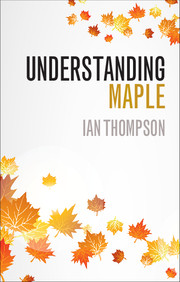1 - Introduction
Published online by Cambridge University Press: 15 December 2016
Summary
He would keep on trying to do this or that with a grim persistence that was painful to watch …
John Wyndham, ‘The Day of the Triffids’Maple is a computer program capable of performing a wide variety of mathematical operations. It originated in the early 1980s as a computer algebra system, but today this description doesn't really do it justice. Maple has facilities for algebra, calculus, linear algebra, graphics (twoand three-dimensional plots, and animations), numerical calculations to arbitrary precision, and many other things besides. It is widely used in universities across the world, and is particularly useful for tasks that are tedious and error-prone when performed by humans, such as manipulating complicated series expansions and solving large sets of simultaneous equations. Used correctly, Maple can save time and quickly solve problems that would otherwise be intractable. Used incorrectly, it can lead to frustration, and the destruction of expensive IT equipment.
At the time of writing, the current version is Maple 2016. Versions before Maple 2015 were numbered starting from 1; the last of these was Maple 18. New features introduced in each version from Maple 4.0 onwards can be viewed using the help system (see Section 2.2). For the most part, recent changes have been relatively minor, at least as far as the material in this book is concerned. Consequently, all of the examples work with both Maple 2015 and Maple 2016. In fact, most will work in older versions as well, though naturally the number of exceptions increases the further back one goes. Two substantial new features are the dataplot command, discussed in Section 6.6, and the new rules concerning terminating characters, described in Appendix B (see also Section 2.3). Both of these were introduced in Maple 2015.
Why This Book?
This book is intended for students, teachers and researchers who will ultimately wish to use Maple for advanced applications. Here, ‘advanced’ means something more complex than evaluating a single integral, but not necessarily designing and running a simulation of the latest jet engine.
- Type
- Chapter
- Information
- Understanding Maple , pp. 1 - 5Publisher: Cambridge University PressPrint publication year: 2016



